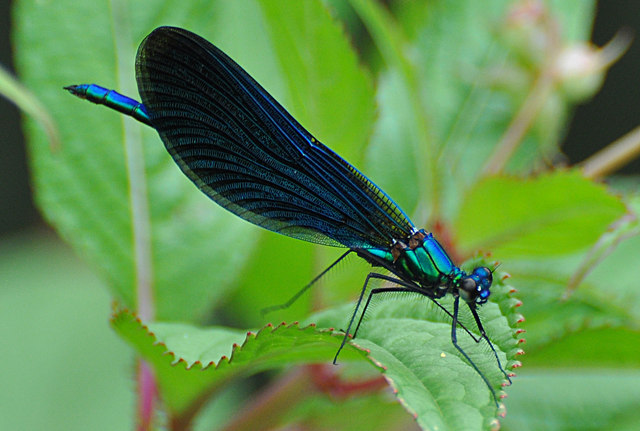Biodiversity
Related Links
Latest News
A Starring Role for Nantclwyd’s Lesser Horseshoe Bats
22.05.2015
Living Landscape Brought Back to Life
05.12.2014
Facebook Page
Beautiful demoiselle
This striking insect spends most of its life underwater as a larva, before emerging to spend only a few weeks as a flying adult. Its vibrant iridescent colouration gives it the apt name of beautiful demoiselle.
 Description and identification: The beautiful demoiselle is a type of damselfly. It has a wing span of around 6cm, and four wings which it holds in a closed position when at rest. The two sexes are different in appearance: the males have a metallic blue-green body and dark-coloured wings, whilst the females have a green body and brown wings. The related banded demoiselle is similar but the male has a large spot on the wing instead of solid pigmentation and the female has green wings.
Description and identification: The beautiful demoiselle is a type of damselfly. It has a wing span of around 6cm, and four wings which it holds in a closed position when at rest. The two sexes are different in appearance: the males have a metallic blue-green body and dark-coloured wings, whilst the females have a green body and brown wings. The related banded demoiselle is similar but the male has a large spot on the wing instead of solid pigmentation and the female has green wings.
Habitat: This species inhabits fast-flowing streams and rivers, with fine sand or gravel substrates, which are often shady with over-hanging vegetation.
Diet: Like all dragonflies and damselflies, the larvae of the beautiful demoiselle are voracious predators, eating anything they can catch! The adults are also predators, catching flying insects on the wing, which they hunt using their excellent eyesight.
Ecology and reproduction: This is one of only three dragonfly and damselfly species in Britain to exhibit true courtship behaviour: the male attracts a female and entices her to mate with his fluttering display flight. Eggs are laid on vegetation within the watercourse and take 14 days to hatch. The larvae remain in the water for two years. When a larva is fully grown it will climb out of the water on a piece of vegetation, and slowly emerge from its larval skin, which can take several hours and leaves the animal vulnerable to predation. The adults survive for only a few weeks. The best time to see them is between late May and late August.
Distribution: In the UK the beautiful demoiselle is found mainly in the south and west of England and in Wales. It is also found across most of Europe, in North Africa and parts of Asia. In Denbighshire it is known from fast-flowing streams and rivers around the county.
Threats: The main threat facing this species is habitat loss, through changes in management of land and watercourses, development and pollution.
Status: This species is not protected by law and is not currently a priority for conservation action since is it sufficiently common and widespread. Work being undertaken to clean up and improve the quality of our rivers and streams, such as the Environment Agency's Water Framework Directive programme, will benefit this and many other species across the UK.



